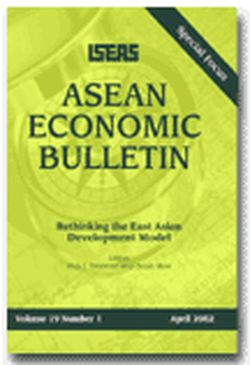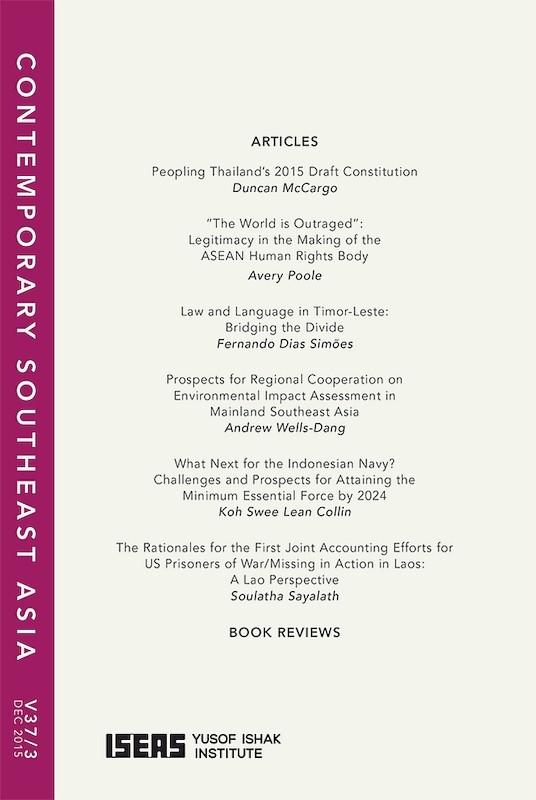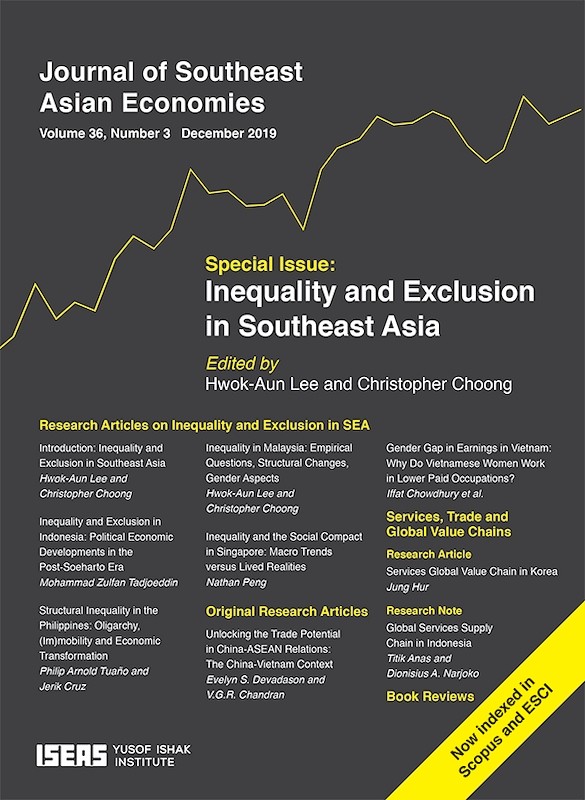ASEAN Economic Bulletin Vol. 24/1 (Apr 2007). Special Focus on Bridging the ASEAN Developmental Divide: Challenges and Prospects

Date of publication:
April 2007
Number of pages:
182
Code:
AE24/1
Contents
-
ASEAN Economic Bulletin Vol. 24/1 (Apr 2007). Special Focus on Bridging the ASEAN Developmental Divide: Challenges and Prospects
-
Preliminary pages
- ARTICLES
-
Bridging the ASEAN Developmental Divide: Challenges and Prospects, by Lorraine Carlos Salazar, Sanchita Basu Das, authors see abstractThis special issue of ASEAN Economic Bulletin zeroes in on the developmental divide among ASEAN member states and analyses how its various forms and aspects pose a challenge to the creation of an ASEAN Economic Community. The articles in this volume seek to assess the state of the developmental divide among ASEAN member countries from the perspective of its middle- and lower-income members. This introductory chapter provides a backdrop to the two regional and six country papers that follow. The article presents a brief overview of the developmental divide and examines some of its indicators. The article then considers the EU experience and attempts to draw some lessons for ASEAN. Finally, the article previews the chapters ahead.
-
Bridging the ASEAN Development Divide: A Regional Overview, by David Jay Green, author see abstractSoutheast Asian countries have set for themselves challenging economic goals individually and collectively. These goals require a significant and sustainable rise in economic growth. Investment is one key, especially in the longer term. Investments in infrastructure, in productivity enhancements by businesses and in the public provision of education and health services help define the potential for growth. This spending is also a factor in the ability of firms and individuals to compete in the international marketplace. There is also the need to have proper co-operative norms: Southeast Asia needs to provide a wider regional market and the policy environment that will allow firms and individuals to participate more fully in international marketplaces. ASEAN has provided a forum for this, particularly looking towards forming the ASEAN Economic Community.
-
The ASEAN Developmental Divide and the Initiative for ASEAN Integration, by Rodolfo C Severino, author see abstractWhen Cambodia, Laos, Myanmar, and Vietnam became members of ASEAN in the late 1990s, concerns were raised about the emergence of a development divide on the basis of a gap in average per capita GDP between the older and the newer members. Such concerns are largely misplaced. There are, however, areas where the divide is real and concerns over it are valid. The Initiative for ASEAN Integration (IAI) has been the principal response of ASEAN and its partners to the development divide. While the four newer ASEAN members have found the IAI projects generally useful, more could be done to make them more coherent, subject their selection and design to greater rigour, strengthen them with provisions for follow-through and assessment, and give the newer members a greater sense of ownership. Aside from the IAI, there are also other programmes for the development of the Mekong Basin, where all the four newer ASEAN members are located. In sum, the development divide in ASEAN is more complex than the difference in economic advancement between the older and the newer members. Programmes to close it should, therefore, be sharply targeted at where the gap precisely lies.
-
The Developmental Gap between the ASEAN Member Countries: The Perspective of Indonesia, by Dionisius Ardiyanto Narjoko, Puspa Delima Amri, authors see abstractThis paper addresses the issue of developmental gaps in ASEAN from Indonesia's perspective by examining the extent to which industrialization in Indonesia have differed in comparison with other ASEAN countries, particularly in the last two decades. The discussion suggests that there has been an increasing gap in Indonesia's industrialization and that the country does not seem to have responded positively to the greater extent of production sharing in the Asian region. In addition to exposing gaps in industrialization, the paper also identifies the role Indonesia plays in the initiative to narrow the developmental gap between the ASEAN-6 and the CLMV countries. Evidence suggests that Indonesia's participation in projects enhancing economic development in the CLMV countries has been limited. There is certainly room for improvement, provided Indonesia is able to recover successfully from its many political and economic problems.
-
Prosper-Thy-Neighbour Policies: Malaysia's Contributions after the Asian Financial Crisis, by Tham Siew Yean, Kwek Kian Teng, authors see abstractThe 1997 financial crisis prompted various governments in the region to launch initiatives to restore economic stability and growth. These efforts also addressed the issue of developmental divide in ASEAN. Within ASEAN, Malaysia ranked second in terms of exports, imports, openness, and foreign reserves. Over the years, with further recovery, Malaysia's development continues to outpace the development of the CLMV countries, thereby enabling it to contribute towards the Initiative for ASEAN Integration (IAI). However, Malaysia's IAI projects are rather small due to funding limitations. This article suggests that the existing programme can be supplemented by outbound training in the individual CLMV countries, which would be more cost-effective and could benefit a larger group of trainees. Also, greater efforts can be made to harness the private sector to fund projects that can meet their strategic interests in these countries.
-
Transitional Economy of Myanmar: Present Status, Developmental Divide, and Future Prospects, by Mya Than, Myat Thein, authors see abstractThis paper assesses the present status of Myanmar's economy in the context of the ASEAN developmental divide, and considers its future prospects. Doing such an assessment is an unenviable task given the poor quality of data. According to official data, Myanmar has been consistently posting double-digit GDP growth rates since 1999-2000. Myanmar's growth is one of the highest in the world for the period and double that of most other countries in the region. However, a number of international organizations have reservations about these double-digit GDP growth rates. More importantly, they are difficult to reconcile with other indicators of development and the lack of any significant structural reforms. Also, the development divide between Myanmar and other ASEAN countries continue to be as wide as ever. The paper concludes by pointing out some of the urgently needed reforms for Myanmar to achieve sustained development: developing the financial sector and establishing development fundamentals.
-
Closer Trade and Financial Co-operation in ASEAN: Issues at the Regional and National Level with Focus on the Philippines, by Jenny D Balboa, Erlinda Medalla, Josef T Yap, authors see abstractTrade and financial policies in ASEAN member countries have contributed to the goal of economic integration. One important feature of this process is the need to narrow the development gap in the region in order to make economic integration more effective and meaningful. This paper examines the Philippine experience with economic reform, particularly in its attempt to integrate with ASEAN. The Philippines simplified its tariff structure and reduced tariffs in accordance with the CEPT Scheme. Monetary and financial reform -- particularly adopting the inflation-targeting framework -- and fiscal consolidation were undertaken to strengthen the financial system and address the fiscal deficit. These efforts also facilitate regional monetary co-operation and integration. However, the Philippines continues to lag behind the larger ASEAN economies particularly with respect to reducing poverty incidence. The Philippine experience has shown the importance of having economic reform supported by strategies to enhance good governance and strengthen institutions.
-
Long-term Economic Performance in Thailand, by Peter Warr, author see abstractThailand's long-term economic growth has been remarkable. This progress has been reflected in the very significant improvement in indicators of well-being, such as life expectancy, infant and maternal mortality, and literacy. Poverty incidence has declined dramatically, but economic inequality has increased. The performance of the education system is chronically weak. Environmental problems and institutional failures in resource management are ongoing. Reform is needed in several areas, including political and corporate governance, trade policy, regulation of industry and the education and health systems. This article attempts to clarify these issues and to suggest the most important areas for reform.
-
Approach to Development Gaps in ASEAN: A Vietnamese Perspective, by Bui Truong Giang, Vo Tri Thanh, authors see abstractDevelopment gaps always exist, but not all gaps are impediments to integration among nations. The challenge for ASEAN's integration is that the increasingly globalized world and current community-building process of ASEAN could turn the region into "the included" and "the non-included" unless ASEAN can find appropriate approaches to bridge in a sustainable manner the crucial development gaps among its members. Such a possibility would threaten the stability and coherence of ASEAN from within rather than from outside. The paper provides a "4-I" approach to the development gaps in ASEAN (Income, Infrastructure, Integration, and Institutional Gaps) in order to speculate possible outcomes and to draw some observations on what has to be prioritized in the community-building process. We consider focusing on regional institution-building and caring for the most vulnerable as the "new ASEAN way" of bridging the development gap and to move towards a sustainable ASEAN Community in the future.





